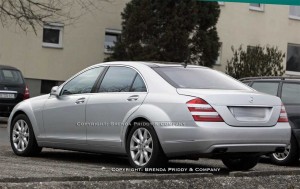The gearbox wars continue to heat up. Mercedes-Benz engineers are trying to determine just how many transmission cogs are enough – and perhaps more importantly, how many the public will accept.
Numbers always seem to matter in the auto industry. But in an era of increasing fuel-efficiency, it’s harder to put a positive spin on big displacement figures, and V6s and I4s are gaining more credibility as the fortunes of the V8 and V12 begin to fade away.
But it’s an entirely different story when it comes to gearboxes. And where a 4-speed automatic might have seemed like plenty, just a decade ago, the numbers have more recently climbed to 5, 6, 7, and even 8. Now, it seems, the Germans are pushing even higher.
New reports suggest that Mercedes is looking at a 9-speed option that would be used with its larger-displacement engines, something that could prove critical if the maker hopes to meet upcoming mileage standards in the U.S., and the strict new CO2 regulations coming in Europe, reports the British magazine AutoCar
.
But don’t expect the automaker to begin work on a 10-speed once the 9 hits the road. Mercedes engineers contend – not surprisingly – that 9 is the upper limit when weighing cost, complexity, size and weight against greater efficiency.
Another factor is just how many gears consumers are willing to accept. While many consumers view a 6-speed as an advantage over older 4-speed automatics, the potential cost penalties of the new transmissions has to be considered. In turn, that has to balanced against potential savings on fuel, which could run anywhere from 2% to 4%, for a 9-speed, according to several experienced sources TheDetroitBureau.com consulted.
Chrysler announced last month that it would license a design for an 8-speed automatic from ZF. (Click Here for more.) Other automakers, including BMW and Lexus are already using 8-speed boxes. BMW and Lexus currently offer 8-speed transmissions in certain models.
Gear changes in those cars are already so silky smooth that the vehicle occupants hardly notice them, so, presumably, the same would be said for a transmission with yet another cog.
These transmissions aren’t, umm, geared, for those who want to be involved in shifting. By and large, manual gearbox developers have been trailing their automatic transmission counterparts, at least in terms of the gear count. The current crop of 8s and 9-speeds are designed for those who want a vehicle that feels more like they’ve settled into a living room easy chair.


This is simply terrific. Yet another “new” gizzie that will not be made to be overhauled, or at least will overhaul at a cost that anyone would want to pay.
I am continually amazed at how little progress has really be made in the automobile in the last fifty years. Adding gears to the transmission, and figuring out how to have airbags pop out from every conceivable orifice with cup holders hanging from every crevice is hardly progress.
If the manufacturers had put as much money into true innovative performance engineering as they have into electric gizzies, we would probably have cars that could get seventy-five miles per gallon of regular gasoline.
Since I have interest in the cars, the new Audi A6 Avant has three hundred horsepower from a very complex V6 engine, and gets a combined EPA mileage rating of 20 miles per gallon.
I compare that with our 1994 Audi 100CS which has 172 horsepower and now, 155,000 miles since new. That car delivers a real world daily driver mileage of 21 per gallon.
Audi would like me to think that the new A6 represents progress? For one quarter the price of a new A6 we can have our 100CS completely rebuilt, including every rubber gizzie, trim piece, tires, and refinishing to new condition. And my insurance premiums and taxes will still be one fourth those of the new A6.
I know I’d still have only four cogs in the gear box, two airbags, and no cupholders, but my old Audi will continue to do everything that the new A6 will do.
Mercedes can keep their foolish nine gear transmission. It will not really help any one of their cars do any one thing better than the previous models. I think that Mercedes should read up on German history. The best and most feared tanks in WWII were the Tigers and Tiger II’s (King Tiger). They were magnificent machines but in the end, their complexity to build and maintained rendered them useless.
I guess it all just means that in the auto industry as in politics, the only thing that we learn from history is that we never learn from history.